[English] 日本語
 Yorodumi
Yorodumi- PDB-6d9j: Mammalian 80S ribosome with a double translocated CrPV-IRES, P-si... -
+ Open data
Open data
- Basic information
Basic information
| Entry | Database: PDB / ID: 6d9j | ||||||
|---|---|---|---|---|---|---|---|
| Title | Mammalian 80S ribosome with a double translocated CrPV-IRES, P-sitetRNA and eRF1. | ||||||
 Components Components |
| ||||||
 Keywords Keywords | RIBOSOME / mammalian / CrPV IRES | ||||||
| Function / homology |  Function and homology information Function and homology informationSynthesis of diphthamide-EEF2 / translation at postsynapse / response to folic acid / positive regulation of cytoplasmic translation / ribosomal subunit / aggresome / lncRNA binding / Uptake and function of diphtheria toxin / Peptide chain elongation / skeletal muscle cell differentiation ...Synthesis of diphthamide-EEF2 / translation at postsynapse / response to folic acid / positive regulation of cytoplasmic translation / ribosomal subunit / aggresome / lncRNA binding / Uptake and function of diphtheria toxin / Peptide chain elongation / skeletal muscle cell differentiation / ubiquitin ligase inhibitor activity / translational elongation / positive regulation of signal transduction by p53 class mediator / 90S preribosome / skeletal muscle contraction / translation elongation factor activity / phagocytic cup / hematopoietic progenitor cell differentiation / glial cell proliferation / Protein methylation / rough endoplasmic reticulum / ribosomal small subunit export from nucleus / translation regulator activity / gastrulation / cellular response to brain-derived neurotrophic factor stimulus / MDM2/MDM4 family protein binding / cytosolic ribosome / class I DNA-(apurinic or apyrimidinic site) endonuclease activity / DNA-(apurinic or apyrimidinic site) lyase / response to endoplasmic reticulum stress / positive regulation of translation / ribosomal large subunit biogenesis / response to ischemia / maturation of LSU-rRNA from tricistronic rRNA transcript (SSU-rRNA, 5.8S rRNA, LSU-rRNA) / positive regulation of apoptotic signaling pathway / maturation of SSU-rRNA from tricistronic rRNA transcript (SSU-rRNA, 5.8S rRNA, LSU-rRNA) / maturation of SSU-rRNA / small-subunit processome / response to hydrogen peroxide / spindle / rRNA processing / antimicrobial humoral immune response mediated by antimicrobial peptide / actin filament binding / p53 binding / rhythmic process / positive regulation of canonical Wnt signaling pathway / response to estradiol / large ribosomal subunit / regulation of translation / ribosome binding / ribosomal small subunit biogenesis / ribosomal small subunit assembly / small ribosomal subunit / 5S rRNA binding / ribosomal large subunit assembly / small ribosomal subunit rRNA binding / large ribosomal subunit rRNA binding / cytosolic small ribosomal subunit / response to ethanol / secretory granule lumen / defense response to Gram-negative bacterium / perikaryon / killing of cells of another organism / cytosolic large ribosomal subunit / Hydrolases; Acting on acid anhydrides; Acting on GTP to facilitate cellular and subcellular movement / ficolin-1-rich granule lumen / cytoplasmic translation / cell differentiation / tRNA binding / postsynapse / mitochondrial inner membrane / postsynaptic density / rRNA binding / structural constituent of ribosome / ribosome / cadherin binding / translation / response to xenobiotic stimulus / ribonucleoprotein complex / cell division / DNA repair / GTPase activity / mRNA binding / apoptotic process / synapse / dendrite / centrosome / Neutrophil degranulation / protein kinase binding / GTP binding / nucleolus / perinuclear region of cytoplasm / glutamatergic synapse / endoplasmic reticulum / Golgi apparatus / DNA binding / RNA binding / extracellular exosome / extracellular region / zinc ion binding Similarity search - Function | ||||||
| Biological species |  Homo sapiens (human) Homo sapiens (human)   Cricket paralysis virus Cricket paralysis virus | ||||||
| Method | ELECTRON MICROSCOPY / single particle reconstruction / cryo EM / Resolution: 3.2 Å | ||||||
 Authors Authors | Pisareva, V.P. / Pisarev, A.V. / Fernandez, I.S. | ||||||
| Funding support |  United States, 1items United States, 1items
| ||||||
 Citation Citation |  Journal: Elife / Year: 2018 Journal: Elife / Year: 2018Title: Dual tRNA mimicry in the Cricket Paralysis Virus IRES uncovers an unexpected similarity with the Hepatitis C Virus IRES. Authors: Vera P Pisareva / Andrey V Pisarev / Israel S Fernández /  Abstract: Co-opting the cellular machinery for protein production is a compulsory requirement for viruses. The Cricket Paralysis Virus employs an Internal Ribosomal Entry Site (CrPV-IRES) to express its ...Co-opting the cellular machinery for protein production is a compulsory requirement for viruses. The Cricket Paralysis Virus employs an Internal Ribosomal Entry Site (CrPV-IRES) to express its structural genes in the late stage of infection. Ribosome hijacking is achieved by a sophisticated use of molecular mimicry to tRNA and mRNA, employed to manipulate intrinsically dynamic components of the ribosome. Binding and translocation through the ribosome is required for this IRES to initiate translation. We report two structures, solved by single particle electron cryo-microscopy (cryoEM), of a double translocated CrPV-IRES with aminoacyl-tRNA in the peptidyl site (P site) of the ribosome. CrPV-IRES adopts a previously unseen conformation, mimicking the acceptor stem of a canonical E site tRNA. The structures suggest a mechanism for the positioning of the first aminoacyl-tRNA shared with the distantly related Hepatitis C Virus IRES. | ||||||
| History |
|
- Structure visualization
Structure visualization
| Movie |
 Movie viewer Movie viewer |
|---|---|
| Structure viewer | Molecule:  Molmil Molmil Jmol/JSmol Jmol/JSmol |
- Downloads & links
Downloads & links
- Download
Download
| PDBx/mmCIF format |  6d9j.cif.gz 6d9j.cif.gz | 5 MB | Display |  PDBx/mmCIF format PDBx/mmCIF format |
|---|---|---|---|---|
| PDB format |  pdb6d9j.ent.gz pdb6d9j.ent.gz | Display |  PDB format PDB format | |
| PDBx/mmJSON format |  6d9j.json.gz 6d9j.json.gz | Tree view |  PDBx/mmJSON format PDBx/mmJSON format | |
| Others |  Other downloads Other downloads |
-Validation report
| Summary document |  6d9j_validation.pdf.gz 6d9j_validation.pdf.gz | 1.9 MB | Display |  wwPDB validaton report wwPDB validaton report |
|---|---|---|---|---|
| Full document |  6d9j_full_validation.pdf.gz 6d9j_full_validation.pdf.gz | 2 MB | Display | |
| Data in XML |  6d9j_validation.xml.gz 6d9j_validation.xml.gz | 368.3 KB | Display | |
| Data in CIF |  6d9j_validation.cif.gz 6d9j_validation.cif.gz | 639.1 KB | Display | |
| Arichive directory |  https://data.pdbj.org/pub/pdb/validation_reports/d9/6d9j https://data.pdbj.org/pub/pdb/validation_reports/d9/6d9j ftp://data.pdbj.org/pub/pdb/validation_reports/d9/6d9j ftp://data.pdbj.org/pub/pdb/validation_reports/d9/6d9j | HTTPS FTP |
-Related structure data
| Related structure data |  7836MC  7834C  6d90C M: map data used to model this data C: citing same article ( |
|---|---|
| Similar structure data |
- Links
Links
- Assembly
Assembly
| Deposited unit | 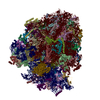
|
|---|---|
| 1 |
|
- Components
Components
-Ribosomal protein ... , 18 types, 18 molecules ACJNVejtEEGGKKMMOORRXXYYddgg
| #1: Protein | Mass: 28088.863 Da / Num. of mol.: 1 / Source method: isolated from a natural source / Source: (natural)  |
|---|---|
| #3: Protein | Mass: 44232.242 Da / Num. of mol.: 1 / Source method: isolated from a natural source / Source: (natural)  |
| #10: Protein | Mass: 20288.465 Da / Num. of mol.: 1 / Source method: isolated from a natural source / Source: (natural)  |
| #13: Protein | Mass: 24207.285 Da / Num. of mol.: 1 / Source method: isolated from a natural source / Source: (natural)  |
| #21: Protein | Mass: 14892.505 Da / Num. of mol.: 1 / Source method: isolated from a natural source / Source: (natural)  |
| #30: Protein | Mass: 15898.932 Da / Num. of mol.: 1 / Source method: isolated from a natural source / Source: (natural)  |
| #35: Protein | Mass: 11111.032 Da / Num. of mol.: 1 / Source method: isolated from a natural source / Source: (natural)  |
| #44: Protein | Mass: 21295.590 Da / Num. of mol.: 1 / Source method: isolated from a natural source / Source: (natural)  |
| #53: Protein | Mass: 31146.607 Da / Num. of mol.: 1 / Source method: isolated from a natural source / Source: (natural)  |
| #55: Protein | Mass: 22913.453 Da / Num. of mol.: 1 / Source method: isolated from a natural source / Source: (natural)  |
| #59: Protein | Mass: 22641.564 Da / Num. of mol.: 1 / Source method: isolated from a natural source / Source: (natural)  |
| #61: Protein | Mass: 18468.826 Da / Num. of mol.: 1 / Source method: isolated from a natural source / Source: (natural)  |
| #63: Protein | Mass: 17259.389 Da / Num. of mol.: 1 / Source method: isolated from a natural source / Source: (natural)  |
| #66: Protein | Mass: 19213.465 Da / Num. of mol.: 1 / Source method: isolated from a natural source / Source: (natural)  |
| #72: Protein | Mass: 14865.555 Da / Num. of mol.: 1 / Source method: isolated from a natural source / Source: (natural)  |
| #73: Protein | Mass: 15784.549 Da / Num. of mol.: 1 / Source method: isolated from a natural source / Source: (natural)  |
| #78: Protein | Mass: 7855.052 Da / Num. of mol.: 1 / Source method: isolated from a natural source / Source: (natural)  |
| #81: Protein | Mass: 18004.041 Da / Num. of mol.: 1 / Source method: isolated from a natural source / Source: (natural)  |
+Protein , 41 types, 41 molecules BFGOQRSTUWXYabcdfhklmprsKBBDDFFLLPP...
-Large ribosomal subunit protein ... , 5 types, 5 molecules DMPgo
| #4: Protein | Mass: 34479.812 Da / Num. of mol.: 1 / Source method: isolated from a natural source / Source: (natural)  |
|---|---|
| #12: Protein | Mass: 21950.322 Da / Num. of mol.: 1 / Source method: isolated from a natural source / Source: (natural)  |
| #15: Protein | Mass: 21741.596 Da / Num. of mol.: 1 / Source method: isolated from a natural source / Source: (natural)  |
| #32: Protein | Mass: 14210.088 Da / Num. of mol.: 1 / Source method: isolated from a natural source / Source: (natural)  |
| #40: Protein | Mass: 12476.973 Da / Num. of mol.: 1 / Source method: isolated from a natural source / Source: (natural)  |
-60S ribosomal protein ... , 6 types, 6 molecules EHILZi
| #5: Protein | Mass: 33028.336 Da / Num. of mol.: 1 / Source method: isolated from a natural source / Source: (natural)  |
|---|---|
| #8: Protein | Mass: 21871.418 Da / Num. of mol.: 1 / Source method: isolated from a natural source / Source: (natural)  |
| #9: Protein | Mass: 24643.057 Da / Num. of mol.: 1 / Source method: isolated from a natural source / Source: (natural)  |
| #11: Protein | Mass: 24331.723 Da / Num. of mol.: 1 / Source method: isolated from a natural source / Source: (natural)  |
| #25: Protein | Mass: 15835.831 Da / Num. of mol.: 1 / Source method: isolated from a natural source / Source: (natural)  |
| #34: Protein | Mass: 12263.834 Da / Num. of mol.: 1 / Source method: isolated from a natural source / Source: (natural)  |
-Protein/peptide , 1 types, 1 molecules n
| #39: Protein/peptide | Mass: 3473.451 Da / Num. of mol.: 1 / Source method: isolated from a natural source / Source: (natural)  |
|---|
-RNA chain , 6 types, 6 molecules 578234
| #45: RNA chain | Mass: 1164731.875 Da / Num. of mol.: 1 / Source method: isolated from a natural source / Source: (natural)  |
|---|---|
| #46: RNA chain | Mass: 38385.750 Da / Num. of mol.: 1 / Source method: isolated from a natural source / Source: (natural)  |
| #47: RNA chain | Mass: 48545.672 Da / Num. of mol.: 1 / Source method: isolated from a natural source / Source: (natural)  |
| #49: RNA chain | Mass: 547733.062 Da / Num. of mol.: 1 / Source method: isolated from a natural source / Source: (natural)  |
| #83: RNA chain | Mass: 28094.645 Da / Num. of mol.: 1 / Source method: obtained synthetically Details: RNA was prepared by in vitro transcription with T7 RNA polymerase Source: (synth.)  |
| #85: RNA chain | Mass: 60789.762 Da / Num. of mol.: 1 / Source method: obtained synthetically Details: RNA was prepared by in vitro transcription with T7 RNA polymerase Source: (synth.)  Cricket paralysis virus / References: GenBank: 8895506 Cricket paralysis virus / References: GenBank: 8895506 |
-40S ribosomal protein ... , 8 types, 8 molecules CCHHIIJJNNZZccff
| #51: Protein | Mass: 30002.061 Da / Num. of mol.: 1 / Source method: isolated from a natural source / Source: (natural)  |
|---|---|
| #56: Protein | Mass: 28751.906 Da / Num. of mol.: 1 / Source method: isolated from a natural source / Source: (natural)  |
| #57: Protein | Mass: 22168.914 Da / Num. of mol.: 1 / Source method: isolated from a natural source / Source: (natural)  |
| #58: Protein | Mass: 24003.012 Da / Num. of mol.: 1 / Source method: isolated from a natural source / Source: (natural)  |
| #62: Protein | Mass: 14538.987 Da / Num. of mol.: 1 / Source method: isolated from a natural source / Source: (natural)  |
| #74: Protein | Mass: 15548.398 Da / Num. of mol.: 1 / Source method: isolated from a natural source / Source: (natural)  |
| #77: Protein | Mass: 9480.186 Da / Num. of mol.: 1 / Source method: isolated from a natural source / Source: (natural)  |
| #80: Protein | Mass: 14498.884 Da / Num. of mol.: 1 / Source method: isolated from a natural source / Source: (natural)  |
-Non-polymers , 2 types, 6 molecules 


| #86: Chemical | ChemComp-ZN / #87: Chemical | |
|---|
-Details
| Has protein modification | N |
|---|
-Experimental details
-Experiment
| Experiment | Method: ELECTRON MICROSCOPY |
|---|---|
| EM experiment | Aggregation state: PARTICLE / 3D reconstruction method: single particle reconstruction |
- Sample preparation
Sample preparation
| Component | Name: Mammalian 80S ribosome in complex with translocated CrPV IRES, P-site tRNA and eEF2 Type: RIBOSOME Details: Mammalian 80S ribosome in complex with translocated CrPV IRES, P-site tRNA and eRF1 Entity ID: #1-#85 / Source: NATURAL |
|---|---|
| Molecular weight | Value: 5 MDa / Experimental value: NO |
| Source (natural) | Organism:  |
| Buffer solution | pH: 7.4 |
| Specimen | Embedding applied: NO / Shadowing applied: NO / Staining applied: NO / Vitrification applied: YES |
| Vitrification | Cryogen name: ETHANE |
- Electron microscopy imaging
Electron microscopy imaging
| Experimental equipment |  Model: Titan Krios / Image courtesy: FEI Company |
|---|---|
| Microscopy | Model: FEI TITAN KRIOS |
| Electron gun | Electron source:  FIELD EMISSION GUN / Accelerating voltage: 300 kV / Illumination mode: SPOT SCAN FIELD EMISSION GUN / Accelerating voltage: 300 kV / Illumination mode: SPOT SCAN |
| Electron lens | Mode: BRIGHT FIELD |
| Image recording | Electron dose: 64 e/Å2 / Film or detector model: GATAN K2 SUMMIT (4k x 4k) |
- Processing
Processing
| EM software |
| ||||||||||||
|---|---|---|---|---|---|---|---|---|---|---|---|---|---|
| CTF correction | Type: NONE | ||||||||||||
| 3D reconstruction | Resolution: 3.2 Å / Resolution method: FSC 0.143 CUT-OFF / Num. of particles: 75654 / Symmetry type: POINT |
 Movie
Movie Controller
Controller


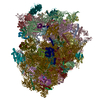

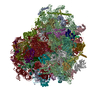
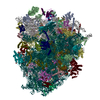
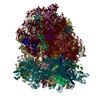

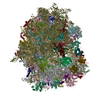
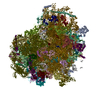
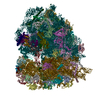
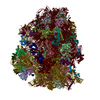
 PDBj
PDBj






































